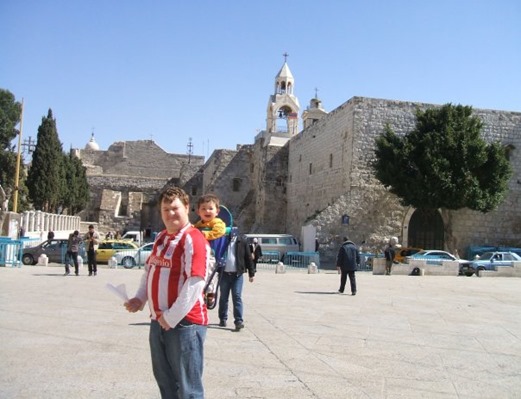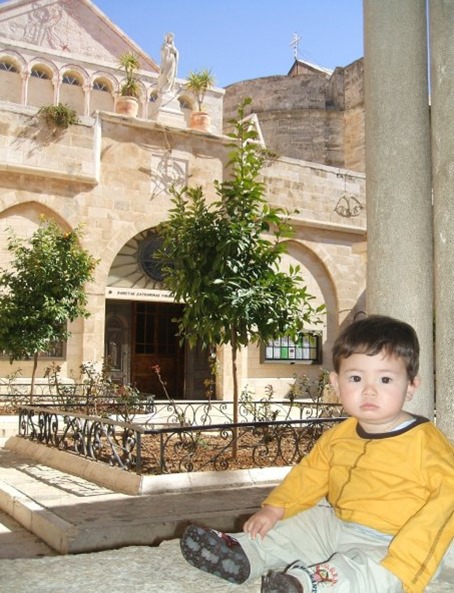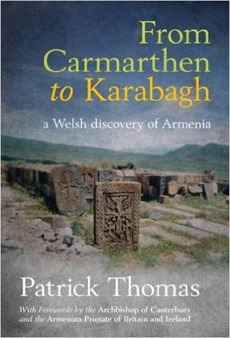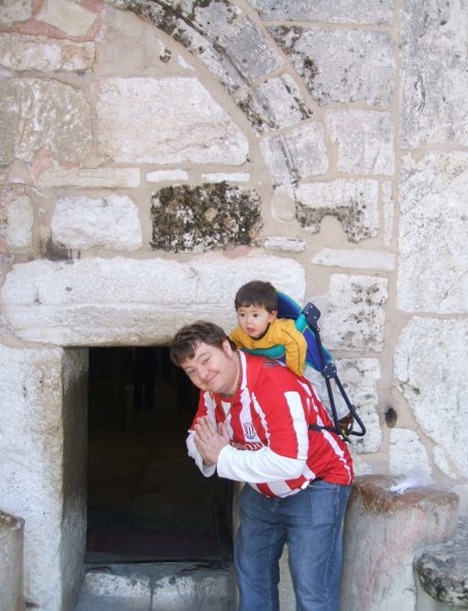Greetings!
My knee improves slowly, (no doubt helped by two remarkable test matches), and I’m able to move again a little and thus start to think about life beyond my settee. And with that comes thoughts of future trips. I’ve ordered a load of books about Cuba which I will read through to give me a bit of a background on that fair isle, but prior to that there’s a more immediate travel concern for in a couple of weeks or so I’ll be off to tour the Highlands of Scotland for the first time ever with my son and mate Paul. To prepare I’m ploughing through Magnus Magnusson’s ‘Scotland: The Story of a Nation’, several thousand years of history condensed into 700-odd pages. It’s a readable tome I suppose, but far too concentrated on kings and battles for my liking and I’m struggling to get a feel for the place so far. Maybe when I get there…?
Another book of interest that I read last weekend was Patrick Thomas’ ‘From Carmarthen to Karabagh: a Welsh discovery of Armenia’.
Thomas is a Welsh clergyman, (I’ve read another of his books on the very different topic of Welsh saints), who discovered Armenia on a pilgrimage a decade ago and has been transfixed ever since. The book is the tale of his love affair with the land, its faith and its people and I recommend anyone thinking of heading to Armenia to give it a go. True, I found the history chapter at the start to be very basic and unfulfilling, but as an introductory guide it would work much better and the later chapters which pick out certain intriguing aspects and episodes from Armenia’s story were fascinating to read and managed to teach even someone like me whose read a bit on the topic some new things. My only criticism is that it can be a tad politically one-sided at times and contains traces of nationalism which, as any regular reader of mine will know, can turn poisonous if consumed too often. That aside though, like with Armenia itself, give it a go!
For those who wish to know more about my trip to Armenia, here’s the link but for now, from one holy land to another, let’s head to Bethlehem…
Keep travelling!
Uncle Travelling Matt
Links to other parts of the travelogue:
Sacred Pilgrimage
Part 2: Ash Wednesday in Jerusalem
Part 4: Exploring the Old City
Part 7: Up the Mount of Olives
Part 8: Further explorations of Jerusalem
Secular Pilgrimage
Part 2: An Introduction to Kibbutz Living
Part 4: The Silence of the Desert
Part 6: Tearing down the Wall!
Part 7: Beautiful (?) Beersheva
Thursday
Having ticked the holiest site on Earth off on one’s pilgrimage list, then it is only natural to next aim for Number 2, particularly if one is in the vicinity. So, it was that the following morning found us bound for the Church of the Nativity in Bethlehem.
Unlike the Holy Sepulchre, this was one place that I had not previously visited, although I had come very close. In the December of 1997, almost a year after my kibbutz experience, I had found myself returning to Israel to catch up with (amongst others) Simeon and Pepi, the charming Bulgarian couple whom I met on my very first trip to Jerusalem in Elton and Adrienne Netto’s camper van back on 22nd January, 1997. To my surprise however, when I arrived, as a couple, they were no more. I found Simeon working in a bakery in Eilat with a rather plain female Belorussian friend who appeared to be far more than just that, (and at the time Simeon continually went on about how beautiful women only let a man down whilst the plain ones had a more inner beauty and lasting quality), whilst Pepi was to be found crashing on the sofa of Katya, the only other Bulgarian on the kibbutz back in those halcyon days but a few months previously. I caught up with them both in the soulless Tel Aviv suburb of Cholon and in fact ended up spending the night on a Jewish settlement on the West Bank,[1] agreeing to meet up with Pepi a week later for the holiest night of the year, (well, ok, technically the second holiest…), Christmas Eve, in Bethlehem.
Not that many people stay in Bethlehem of course, a town synonymous for poor accommodation options the world over, so bad that even God can only crash in a cave there. Nowadays, all the cheap sleeps are in Jerusalem, so we’d toured the hostels of the Old City Pepi and I, but there was no room at the inn(s) until eventually the Al-Arab Hostel said that they had space but, being holy in the holiest of all cities, it was only available if we were married. “But I am married,” replied Pepi in all honesty, (and with a ring to prove it), and since they never asked to whom, we found shelter and then headed out by bus to join the worshipping throngs in the Church of the Nativity.
Except that the church was full, booked by the Roman Catholics for Mass apparently, and so we were left outside in Manger Square with a service in seven languages and Yasser Arafat’s wife as a celebrity celebrant, (he was inside at the actual Mass). Nonetheless, it was a glorious night; the air was pungent with joy and celebration and I was with a girl who not only felt alienated from her faith and culture, alone and in need of a friend, but was also stunningly attractive and possessing the sexiest accent on earth. Oh how blind youth can make us, and yet at the time how sublime it all is!
In 2009 however, I was married, somewhat fatter, kid in tow and the celebratory mood had been replaced by a chaotic Palestinian bus station. That said, would I have changed things? Of course not, after all, Stoke City were not a Premier League team back then…
I say a Palestinian bus station, because Bethlehem is a Palestinian town. Back in 1997 that meant a checkpoint en route, but in 2009 it meant a whole lot more for in those intervening years peace has alas, become more distant rather than closer and since 2005 a ‘Security Barrier’ (read ‘New Berlin Wall’), has hermetically sealed the West Bank off from the rest of the country that it is purportedly part of.[2]
Like most of the world, I had seen images of this wall on the TV and in the newspapers and, (particularly after visiting Berlin in 2007 and learning all about the world’s other famous ‘security barrier’ that had inspired this one), was interested to see what it looked like in reality. Sat on a Palestinian bus travelling up out of Jerusalem I did see it, snaking across the barren Judean Hills, separating Jew from Arab. It was heart-breaking; that one man can so hate his brother that he needs to put such a barrier up is indescribably sad. It also struck me on one level as perhaps the most stupid thing that Israel could ever have done. Whilst the right-wing politicians may argue that it reduces terrorism, (and the evidence is that it does), from a PR point of view, it has to be a disaster as it virtually screams to the world that Israel is the evil aggressor. There are arguments on both sides as to the rights and wrongs of the Israeli-Palestinian conflict, yet such a visible symbol of hatred and intolerance is surely impossible to justify whatever one’s opinions. I, who have always tried to steer a middle path with regards to Israel and her Arab neighbours, found myself angered by the State of Israel when I saw that concrete knife slash across an ancient land. Like with its now-demolished brother around Berlin, I would hate any state that could build such a structure, whatever their reasons may be.
 In Manger Square, with the Church of the Nativity in the background
In Manger Square, with the Church of the Nativity in the background
The town of Bethlehem sprawls over many hilltops, is scruffy around the edges, but it is also atmospheric and considerably more tourist-friendly – and richer – than any other Palestinian town. Its population may be majority Muslim these days,[3] but the flocks of pilgrims and various religious institutions maintain a distinctly Christian feel to the place. That said, they do not ruin it as can easily happen in places of pilgrimage. When I stepped through the Door of Humility, (so called because one has to bow down to pass through it – not an easy task when carrying a baby on your back! – as it is only four feet high),[4] the atmospheric church built in the time of the Byzantine Emperor Justinian was almost entirely empty.
We made our way to the Grotto of the Nativity underneath the main altar where, over 2,000 years ago, Christ was born, and there we paid our respects. Although the object of my pilgrimage had always been Jerusalem, in many respects I felt Bethlehem to be more fitting, since Tom, for whom we were thankful and thus making the journey, had been born on the 25th December, the day traditionally ascribed as Christ’s birthday, (even if it may not have been the actual date), and so it was perhaps fitting that he paid a visit to the birthplace of his more illustrious fellow Christmas Day baby.
 Same birthday, same place, different baby: Tom visits the Star of Bethlehem, the exact spot when Christ was born.
Same birthday, same place, different baby: Tom visits the Star of Bethlehem, the exact spot when Christ was born.
Like the Church of the Holy Sepulchre, the Church of the Nativity is not one church but instead a collection of them, its different parts being run by different denominations. After visiting the Grotto itself, we explored the other parts; Armenian, Roman and Greek, dating from the reign of Justinian up until the 19th century, and then went out to look at the town itself. Although its hilly location is pleasant, there is not actually a great deal to see or do in Bethlehem and most of what there is I had seen or done eleven years before with Mrs. Kovatcheva so, after browsing through the magnificent collection of souvenir emporiums full of crucifixes, rosaries, fridge magnets and vials of Jordan water labelled in Russian, Thao retired to the tourist information centre to attend to the nappy needs of Tom whilst I headed up a side street to seek out the Milk Grotto.
 Tom outside the Roman Catholic Church of St. Catherine
Tom outside the Roman Catholic Church of St. Catherine
My hopes were not high; it was more just a place to visit rather than somewhere that actually warrants a visit. The church was founded on a legend that tells that when the Holy Family were escaping from King Herod to Egypt, a drop of milk fell from Mary’s breast and turned all the rocks in that place white. Now, as legends go, that one is sufficiently silly and disappointingly devoid of any kind of worthwhile religious message to be remembered for all eternity and so it has proved, with the site being a place of pious veneration ever since.
Cheesy as the legend might have been, the church located of the milky white catacombs was, in fact, quite moving. Although most of it was quite new, (or at least, renovated), it was tastefully done and a superb place to reflect in silence, (I was the only visitor). Like with Walsingham in England, I found that God can be present in even the cheesiest of folk tales and indeed, is often more present and tangible in such places than elsewhere. I left more respectful of the story and the church that it had produced. It was a worthwhile side trip.
Getting back to Jerusalem was an unnecessarily complicated affair. We had to take a taxi to the edge of town where the minibuses stopped and then on a tour of the suburbs in said bus. It was packed and I stood which gave me a chance to people-watch. Most of our fellow travellers were Palestinian university students, some of the female ones quite fetching. A girl sat beside me had a book on teacher-training in Arabic and English and was tempted to try and strike up a conversation on the theories of Maslow, Kolb and Schön, but then realised that that would be more than a little bit sad and also most likely unwelcome. In front of me stood another striking girl who wore tight jeans and no headscarf which seemed quite shocking compared with the attire of all her other female compatriots, but when she crossed herself at every church that we passed and I realised that she was a Christian.
Then media generally portrays the Palestinians as Muslim, often fanatical at that, and whilst this may be true in part, it should also be remembered that there has always been a significant portion of the Palestinian Arab population that is Christian and has kept the faith alive in the Holy Land far better than the Crusaders ever did with their swords. That minority however, is dwindling due to the higher birth rates of the Muslims and the opportunities to migrate overseas being more for the Christians who tend to be richer. In a perverse way, Israel’s policies have helped destroy the Palestinian moderates (i.e. their potential allies) and increase the hardliners who are almost all Muslim and from the poorest sections of society for whom migration is simply not an option.
Israeli policies again came to the fore when we stopped at the ‘border’ checkpoint in the wall. Entering Palestine we had been neither stopped nor checked – after all, why should Israel care about weapons and terrorists leaving their territory? Coming back however, it was a different story entirely; the bus was stopped and everybody made to present their ID. As tourists we had no problems and were not even required to leave the bus, but each and every Arab was ordered off and scrutinised intently. As this happened, I watched the other travellers at the border. Each Palestinian vehicle was checked thoroughly whilst the Jewish cars, (they have different number plates), containing settlers one assumed, sailed through without even having to stop. The injustice of it all was infuriatingly tragic, (after all, whatever one’s political affiliations might be, one has to admit that the settlers too have resorted to violence as well over recent years). The whole tragedy for me however, was encapsulated by one young Palestinian lady in the next lane who, alone out of a whole busload, had been refused entry into Israel for whatever reason. Her tears and pleas were being dismissed perfunctorily by the guards – females of a similar age to herself – who then waved to the passing be-yarmulked settlers. The frustration in her face was the frustration of an entire people powerless in the face of adversity. I, neither a Muslim nor a Jew, with many Israeli friends, someone who believes firmly that Israel has a right to exist and defend herself and is, in so many respects, a positive enterprise, found the scene maddening. What such episodes must do daily to the psyche of a Palestinian, I dare not imagine.
Next part: Exploring the Old City
[1] See ‘Settling Into Israel’
[2] The Israelis declared both the West Bank and the Gaza Strip to be part of the State of Israel in 1967. This has never been recognised by the UN or the international community.
[3] This has not always been the case, for as recently as 1947 the town was 75% Christian. The Arab Christian minority has been one of the main casualties of the Israeli-Palestinian violence and has left in droves to America and other countries. The Christian population of Bethlehem today stands at around 12% of the total.
[4] The door was originally much larger but it was bricked up in Ottoman times to prevent mounted soldiers from entering as the Church of the Nativity was often attacked and indeed, even today it looks more like a fortress than a church which proved useful when the church was occupied by Palestinian militants and besieged by the Israeli Defence Forces in May 2002.






No comments:
Post a Comment